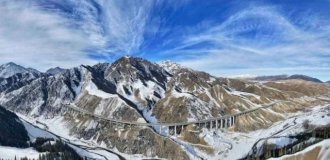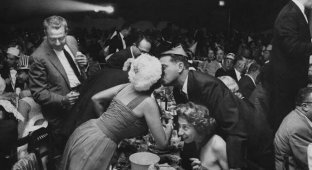Unusual and interesting photos from different countries of the world, taken in the 20th century (21 photos)
This collection will introduce you to rare photographs from different parts of the world taken in the 20th century. The peculiarity of the publication is that all the photos were colored. 
A boy with a toy set in a car repair shop fixes his bike while his father fixes a car. Australia, 1955 
An Egyptian water carrier fills jugs in the Nile River, circa 1910.
For the Egyptians, the Nile is not just a river, but a source of life, a symbol of prosperity and the foundation of the entire ancient Egyptian civilization. The Nile flows through the arid regions of North Africa, turning the river valley into an oasis among the lifeless sands of the Sahara. The water of the Nile became a key condition for the existence of people, animals and plants in the region. 
The Soviet pavilion with a large sculpture of a hammer and sickle at the Expo '67 in Montreal, Canada, 1967.
In 1967, the Expo '67 World's Fair was held in Montreal, Canada, where the Soviet Union presented its exposition, traditionally executed at the highest level. For participation in the exhibition, Soviet architects designed a unique pavilion, which became one of the most striking examples of architectural modernism of that time. The project was distinguished by bold and innovative solutions. Its main feature was a massive roof, which rested on two pairs of V-shaped steel supports. Transparent glass facades gave the building a monumental and airy appearance at the same time, harmoniously combining severity and lightness. After the exhibition ended in October 1967, it was decided to dismantle the pavilion and transport it to Moscow for reassembly. Dismantling and subsequent assembly in Montreal were carried out by the Italian company Feal. However, due to differences in the terrain and climatic features, the project required revisions. A first floor and a basement were added, a wide staircase leading to the second floor was added to the facade, and the heating and ventilation systems were redesigned. Thanks to the construction of a concrete stylobate, the building became taller, but lost some of its original lightness. The lower parts of the V-shaped supports were covered with glazing, and the interior layout was significantly redesigned. The pavilion has survived to this day and is located on the territory of VDNKh in Moscow. Currently, a plan is being considered for its reconstruction, while preserving the original architecture. It is proposed to create a multifunctional space inside: transformable halls for events for 3,700 people, a 3D cinema, dressing rooms, food court areas and retail space. 
Photographer: Ron Case
Girl with braids. Finland, 1966.
Ismo Hölttö's photographs do not show the prosperous Finland that is often shown, but a country going through a period of profound change. Hölttö captured the lives of rural people who faced the harsh realities of their time: unemployment, difficult living conditions in the north, and the need to leave their homelands in search of a better life in other cities or even abroad. 
Photographer: Ismo Hölttö
The boys caught a large cod near Gascon, Quebec. Canada, 1943.
Cod live in deep waters, so they cannot be caught from the shore. So either they washed up on land or their fathers, the fishermen, let them hold their catch. 
A Bedouin woman with facial tattoos. Al-Karak, Jordan, 1947.
The Bedouins are Arab nomadic tribes traditionally found in the Middle East and North Africa. Their way of life has historically been associated with nomadic herding: they raised camels, sheep, goats, and cows, moving across deserts and semi-desert areas in search of pastures and water. 
A child's coffin. Mexico, 1954. 
Children swinging on a swing. Finland, 1950s
The swing in the village of Kukkola and the adjacent swing structure were a meeting place for young people almost 200 years ago. People from their parish and neighboring parishes came to swing on the swing. People used to meet members of the opposite sex there, swing, dance and have fun. Now the world has changed. The swing is chained and looks abandoned, but it's still there. 
Swamp Rafting. Alberta, Canada, 1938. 
A flutist on the road to Cuzco, Peru, 1954. 
Photographer: Werner Bischof
A meeting in the desert. Algeria, 1969.
A meeting of some important guest is an honor guard. The plane was initially assigned to the 235th Separate Government Detachment of the USSR, then transferred to Algeria in 1963. 
Photographer: Yakov Khalip
Calcutta, India, 1951. 
Photographer: Werner Bischof
Ireland, 1952. 
Photographer: Henri Cartier-Bresson
Miners, Dhanbad, Bihar, India, 1989. 
Photographer: Sebastiao Salgado
A worker unrolls a flatbed locomotive. Ireland, 1960.
The turntable required at least two people, but the second one is not visible because of the locomotive. 
Water carrier. Persia, 1901.
A wineskin is a traditional container used to store and transport liquids, primarily water, milk, kumiss or wine. Wineskins were widely used in the everyday life of nomadic peoples such as the Bedouins, Mongols, Turkic peoples and others living in the steppes, deserts or mountainous regions. 
Photographer: A. Sevryugina.
Ecuador, 1982. 
Photographer: Sebastian Salgado
On the street in Rasht. Persia, 1900. 
Photographer: A. Sevryugin.
Children. Patna, India, 1951. 
Topless shoe shine. Toronto, Canada, 1975.
That decade, Toronto was famous for its relaxed and liberal morals. In Canada's largest city, there was a salon where half-naked girls shined shoes. Most likely it was a publicity stunt. 























